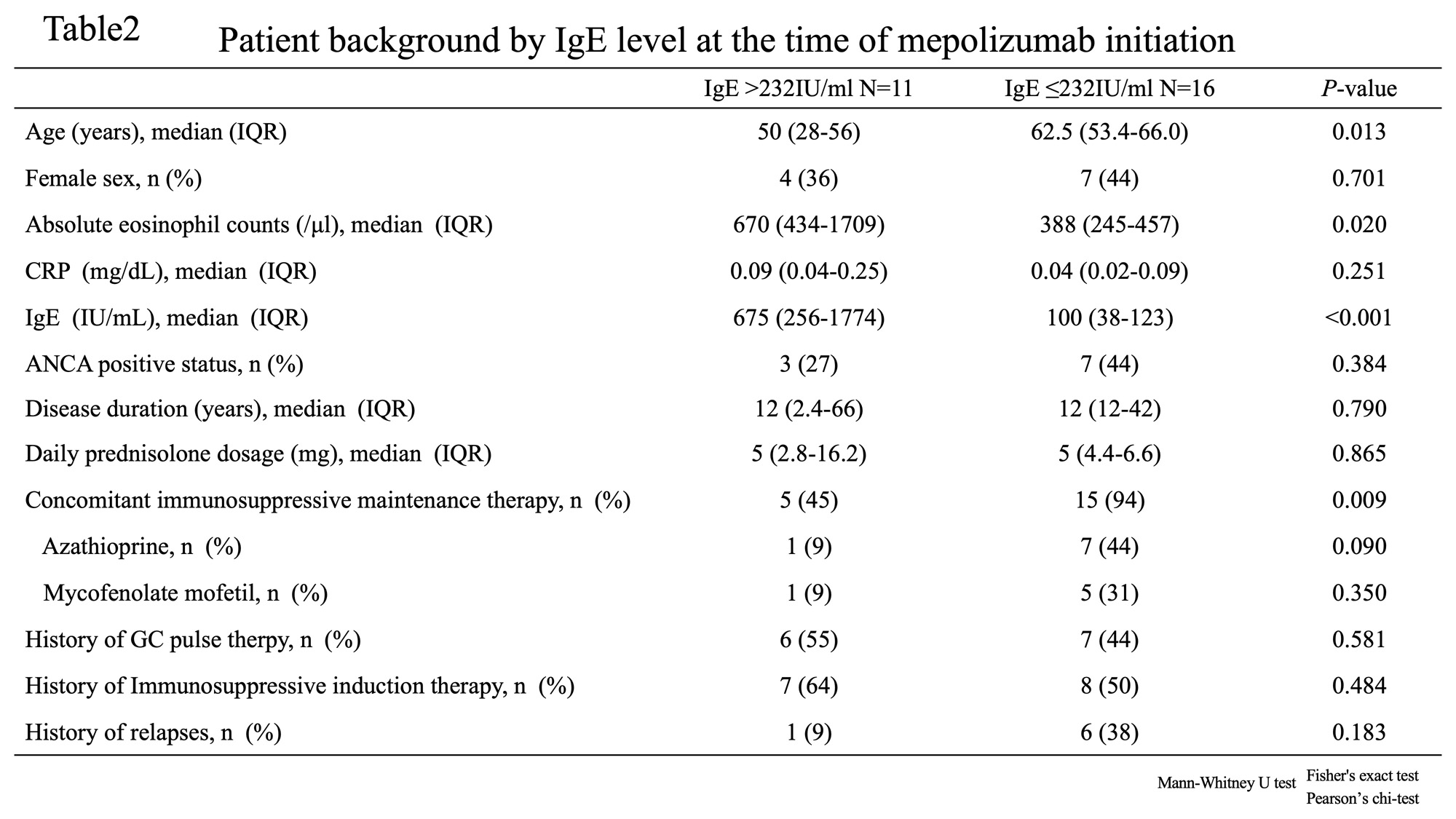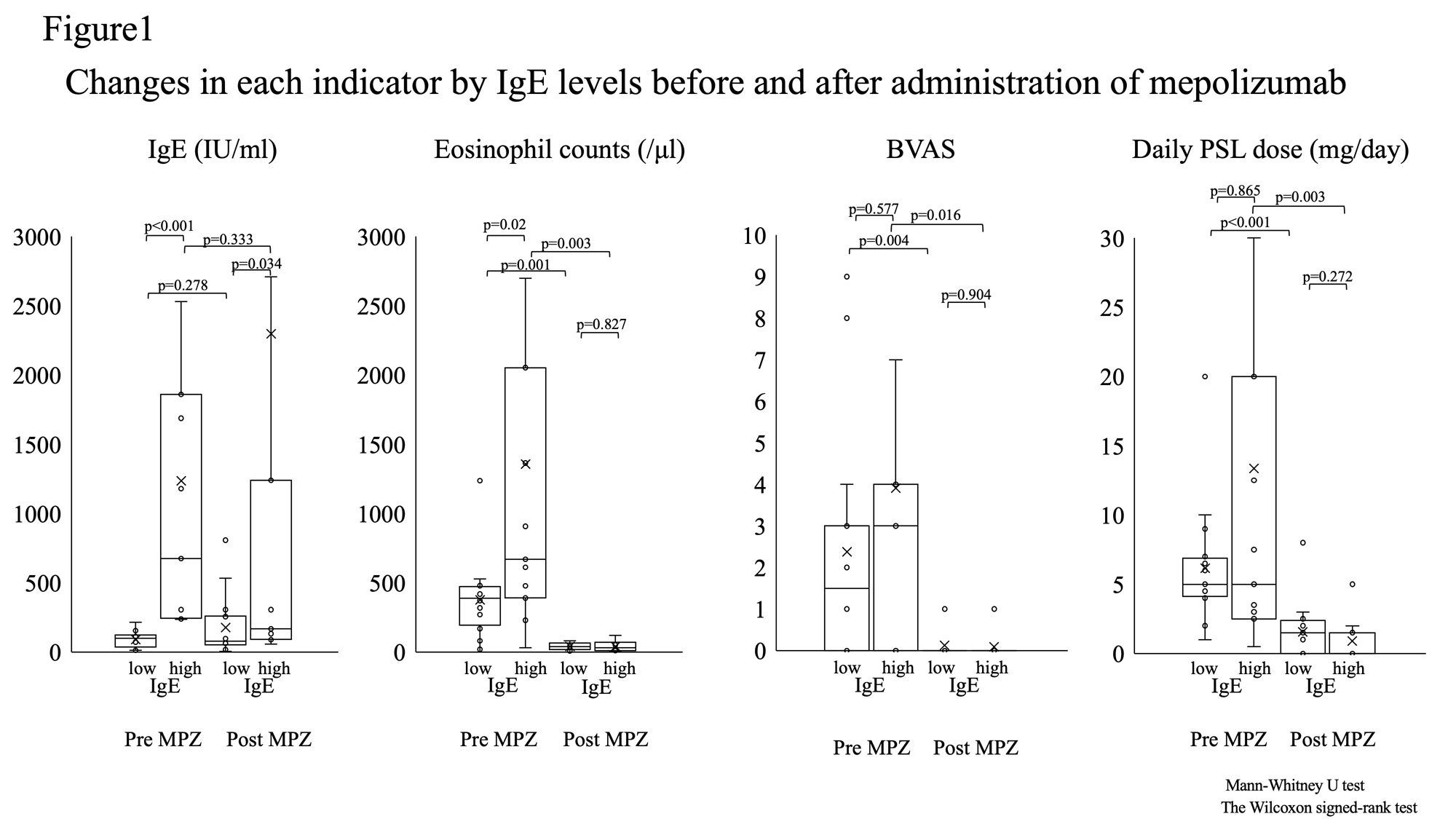Session Information
Date: Sunday, November 12, 2023
Title: (0673–0690) Vasculitis – ANCA-Associated Poster I: Treatment Outcomes
Session Type: Poster Session A
Session Time: 9:00AM-11:00AM
Background/Purpose: Eosinophilic granulomatosis with polyangiitis (EGPA) is a systemic vasculitis associated with eosinophil infiltration and Anti-neutrophil cytoplasmic antibody (ANCA) production. Mepolizumab (MPZ), an anti-IL-5 monoclonal antibody, facilitates good disease control, but the evidence for glucocorticoid (GC) discontinuation is still insufficient. In daily clinical practice, IgE levels along with peripheral blood eosinophil counts, ESR and CRP levels are used to evaluate disease activity, but they are limited in their ability to predict disease recurrence. In this study, we investigated the significance of IgE levels in the process of reducing or discontinuing GC in patients with EGPA.
Methods: Patients with EGPA at Kakogawa Central City Hospital as of January 2023 were classified into two groups: IgE high ( >232IU/ml) and IgE low (≤232IU/ml) at the start of MPZ. The diagnosis of EGPA was based on the 1990 American College of Rheumatology criteria. The differences in patient backgrounds were examined by IgE, eosinophil count, Birmingham Vasculitis Activity Score (BVAS), daily prednisolone (PSL) dose and Vascular Damage Index (VDI). The rate of GC discontinuation and disease relapse were also examined. Statistical analysis was performed using SPSS version 26 (IBM Corp, Armonk, NY, USA), and P< 0.05 was considered significant.
Results: 27 patients had received MPZ for median 34 months. Patient background at the initiation of MPZ was median 59 years and 11 female (41%), disease duration was median 3 years (Table1). The eosinophil count was median 432/μl, CRP 0.06mg/dl, IgE 128 IU/mL, and 11 patients (41%) were in IgE high group. When compared the IgE levels at the initiation of MPZ, patients with high IgE were significantly younger. In addition, eosinophil counts were significantly higher in patients without concomitant immunosuppressive drugs (Table 2). After MPZ initiation, eosinophil counts, BVAS and the daily PSL dose were significantly reduced in both groups while IgE levels did not change at all (Figure 1). Significant improvement in VDI was observed in patients with low IgE. GC discontinuation was achieved in 7 patients (64%) in the high IgE group and 6 (38%) in the low IgE group (p=0.182), and patients who achieved GC discontinuation had no disease relapse during a median follow-up of 19 months.1 patient with low IgE experienced a disease flare-up, which subsequently went into remission with continued administration of MPZ.
Conclusion: Although there is a limitation of single center retrospective data, more than half of the EGPA patients were able to discontinue GCs after approximately 3 years of treatment with MPZ. Notably, IgE levels did not appear to affect the reduction in GC or the achievement of GC discontinuation.
To cite this abstract in AMA style:
Yamane T, Hashiramoto A. Mepolizumab Can Achieve Glucocorticoid Discontinuation in Eosinophilic Granulomatosis with Polyangiitis Patients Regardless of IgE Levels: A Retrospective Study at a Single Center [abstract]. Arthritis Rheumatol. 2023; 75 (suppl 9). https://acrabstracts.org/abstract/mepolizumab-can-achieve-glucocorticoid-discontinuation-in-eosinophilic-granulomatosis-with-polyangiitis-patients-regardless-of-ige-levels-a-retrospective-study-at-a-single-center/. Accessed .« Back to ACR Convergence 2023
ACR Meeting Abstracts - https://acrabstracts.org/abstract/mepolizumab-can-achieve-glucocorticoid-discontinuation-in-eosinophilic-granulomatosis-with-polyangiitis-patients-regardless-of-ige-levels-a-retrospective-study-at-a-single-center/



